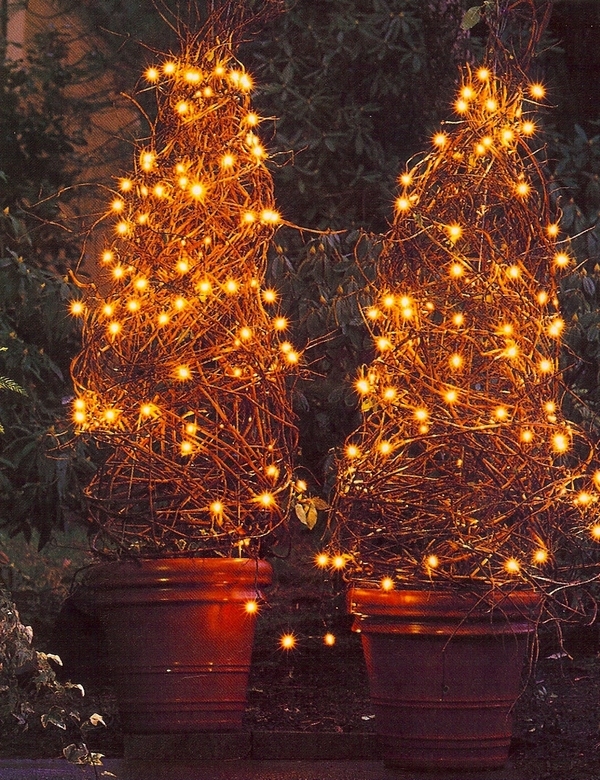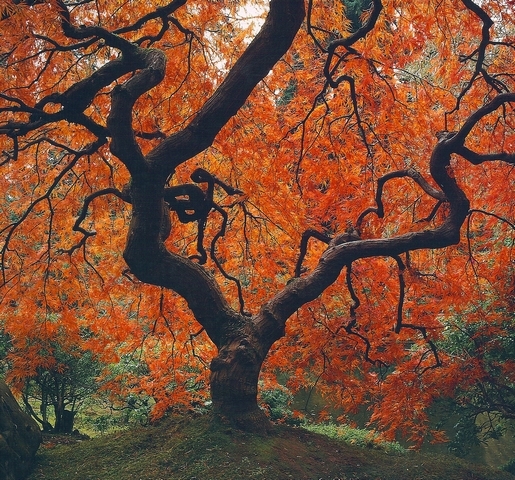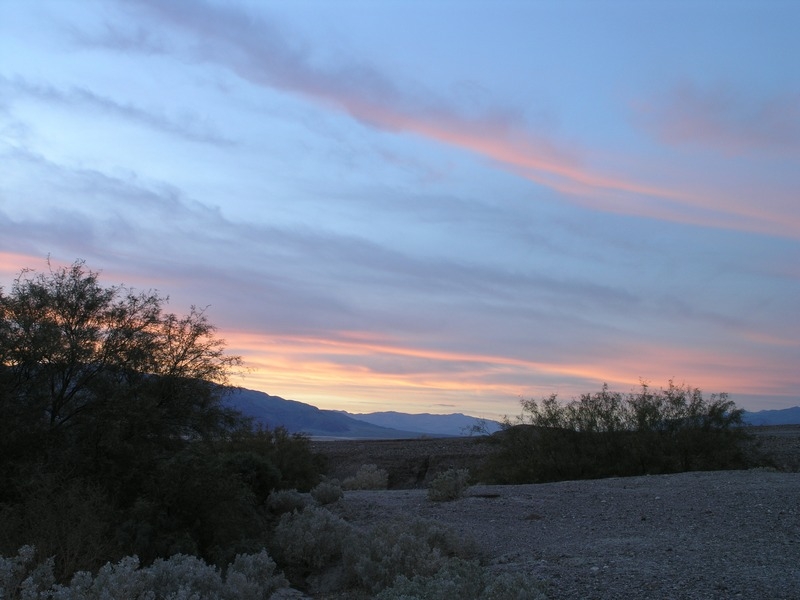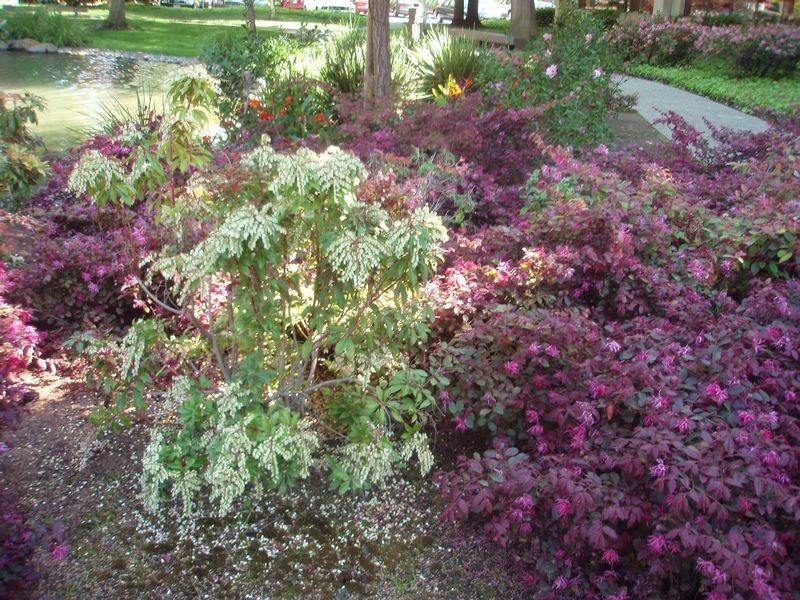It’s great to see so many magazines and TV shows showcasing quick, inexpensive Christmas gifts and decorations to make from simple objects. As we all try to reduce, reuse and recycle , here’s an idea that you can use to decorate your deck or front porch with items you already have.
What’s more "green" than recycling your own garden cuttings? You probably have a large pot where the plants are just about through for the season. Pull out the spent plants but keep the soil. You’ll be making a Christmas "tree" from a tomato cage turned upside dow n and secured with large U-shaped staples poked into the pot’s soil. Tie the wire prongs that are normally sunk into the ground with twine to make a pointed top.
n and secured with large U-shaped staples poked into the pot’s soil. Tie the wire prongs that are normally sunk into the ground with twine to make a pointed top.
Once the cage is anchored in place you can weave prunings from grapevines or honeysuckle in and around it. Any vine will work as well as long flexible branches from shrubs like cotoneaster, willow or abutilon.
If you have an electrical outlet nearby you can weave small lights throughout the tree. If you want to get fancy, poke dried hydrangea flowers or berry sprigs or rosemary cuttings into the "tree". After the holidays, you can plant primroses in the container and store the tomato cages for next summer.
It’s not too late to plant bulbs. We get enough cold around here for many more months so the bulbs will get enough chilling even though you’re getting a late start. The worst that can happen is the blooms may be slightly smaller and bloom on shorter stems. I always start my bulbs about now as the squirrels have buried most of their acorns for the season and tend to leave my pots alone. If they do discover them, I put gravel over the the surface and that seems to stop the party. I plant lots of pots because the color will be so welcome in early spring.
A simple ( read lazy ) way to plant that I’ve always had success with is to reuse the soil in a pot that just finished up like impatiens or other annuals. Some I plant with cool season color but many, especially the glazed ones, I take out half of the soil, layer some bulbs, and pack the top with the rest of the soil. Voila ! Instant spring bouquet in less than two minutes. If you haven’t planted any bulbs yet, do go out and get some now. You’ll be very glad you did.
A word to the wise: protect against killing frosts that often hit this month. Watch out for still, starry nights and be prepared to protect tender plants with frost blankets. Even a sheet, tarp, cardboard box, or regular blanket will help. If you do use plastic, make sure it is supported by poles and not draped right on top of the plant. Better yet, sink four 1×1 stakes to make a frame around tender plants, then you’ll be ready to throw something over quickly on a cold night. Plants must be watered adequately to survive a freeze. Drought stressed plants are more susceptible to damage.
A plant that’s hardy, drought tolerant, blooms in the winter and makes a nice wreath, too, is the rugged rosemary. One of the most versatile of all herbs, rosemary can be used in a variety of ways in both the garden and kitchen. You can use an upright version like for a deer resistant screen. Low. prostrate types make great ground covers. And they do well in pots on the deck or outside the kitchen door. Native to the Mediterranean region, rosemary tolerates a wide variety of growing conditions from hot sun to partial shade and survives down to around 15 degrees. It will accept regular watering as long as there is good drainage. You can add it to a mixed perennial bed or delegate it to the back forty. Rosemary will flourish for decades in your garden but too much fertilizer will result in a shorter-lived plant.
Harvest leaves for cooking anytime. Plant some by the barbeque so you can toss plant sprigs over the coals to flavor food as it cooks. Or use rosemary branches dipped in sauce to baste grilled food. Mmm… yummy.

 Leaves change color when they are going into winter dormancy. When nights get long enough, leaves develop a corky layer of cells between the leaf stalk and the woody part of the tree. This slows the transport of water and carbohydrates. The manufacture of chlorophyll is slowed and the green color of the leaves begins to fade, allowing the other pigments to show through. Since the transport of water is slowed down, food manufactured by the remaining chlorophyll builds up in the sap of the leaf and other pigments are formed which cause the leaves to turn red or purple in color, depending on the acidity of the sap.
Leaves change color when they are going into winter dormancy. When nights get long enough, leaves develop a corky layer of cells between the leaf stalk and the woody part of the tree. This slows the transport of water and carbohydrates. The manufacture of chlorophyll is slowed and the green color of the leaves begins to fade, allowing the other pigments to show through. Since the transport of water is slowed down, food manufactured by the remaining chlorophyll builds up in the sap of the leaf and other pigments are formed which cause the leaves to turn red or purple in color, depending on the acidity of the sap.  After returning, I’m struck with the lushness of our subtropical home. You probably get this same feeling when you get back from a vacation. We live in paradise. Whether you live in oak woodlands, chaparral, or a redwood / mixed evergreen forest we are blessed to live here. We are thankful for our neighbors and community, our flora and fauna, our wonderful climate and our gardens. I came across this poem of Thanksgiving and thought you might like it, too.
After returning, I’m struck with the lushness of our subtropical home. You probably get this same feeling when you get back from a vacation. We live in paradise. Whether you live in oak woodlands, chaparral, or a redwood / mixed evergreen forest we are blessed to live here. We are thankful for our neighbors and community, our flora and fauna, our wonderful climate and our gardens. I came across this poem of Thanksgiving and thought you might like it, too.  of flowers if you’re lucky. Mexican bush sage are still blooming as are lion’s tail, maybe a few cosmos, Japanese anemones and asters. Ornamental oregano holds up well , too, especially the variety Santa Cruz. Foliage can be a key player and might be found from smoke bush, ornamental grass, purple hopseed, crape myrtle, Chinese pistache, oaks, maples and liquidambar. Dogwood leaves would be beautiful as would ornamental pear. Berry accents are a staple for a fall bouquet and you might have nandina, cotoneaster, hawthorn, dogwood or crabapple in your garden. Go out and fill a brown shopping bag with whatever strikes your fancy to create a beautiful fall bouquet to give or dress up your own table or entry. Your arrangement should last about 4-7 days in a moderately cool room.
of flowers if you’re lucky. Mexican bush sage are still blooming as are lion’s tail, maybe a few cosmos, Japanese anemones and asters. Ornamental oregano holds up well , too, especially the variety Santa Cruz. Foliage can be a key player and might be found from smoke bush, ornamental grass, purple hopseed, crape myrtle, Chinese pistache, oaks, maples and liquidambar. Dogwood leaves would be beautiful as would ornamental pear. Berry accents are a staple for a fall bouquet and you might have nandina, cotoneaster, hawthorn, dogwood or crabapple in your garden. Go out and fill a brown shopping bag with whatever strikes your fancy to create a beautiful fall bouquet to give or dress up your own table or entry. Your arrangement should last about 4-7 days in a moderately cool room. 